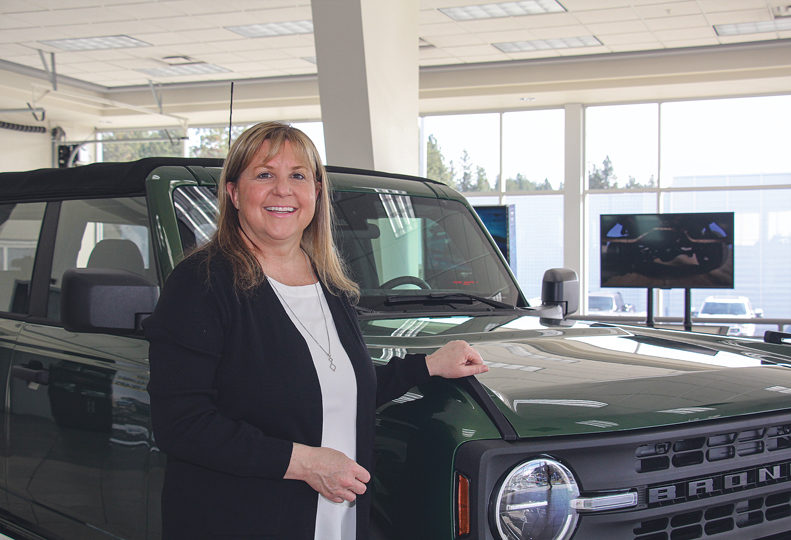
Home » Car Conundrum: INW auto dealers have the demand, but struggle to secure the vehicles amid shortage
Car Conundrum: INW auto dealers have the demand, but struggle to secure the vehicles amid shortage
Supply-chain issues for manufacturers felt at local level

March 10, 2022
New car buyers will notice many empty spaces on lots at dealerships around Spokane, and managers at some dealerships here say they expect inventories for new cars in 2022 to remain in short supply due to soaring inflation, a shortage of semiconductors, and other supply-chain issues.
There is hope for new car inventories to pick up by year-end and for the market to stabilize in 2023, they say, although some auto dealers here add that the way they’ll conduct business going forward likely has changed for good.
Kristin Goff, president of Wendle Motors Inc., says the Wendle dealership currently has about 50 new cars in stock, whereas pre-pandemic new car inventories would normally be over 250 on the lot.
Wayne Cornwell, president of Becker Buick GMC, says he had two new cars on the ground at the dealership, as of March 3. Cornwell says he expects to receive delivery of 12 to 15 new cars this month, although those vehicles have already been sold.
“The customers are either buying them ahead of time or they’re saying, ‘I want that when it gets here.’ So, the 12 that get here in March, won’t ever be on the ground because they’ll all be spoken for,” Cornwell says.
Preorders have helped new-car sales, and customers seem to like selecting the exact features they want, but Cornwell says the wait times for a customer who orders a GM vehicle is six months to a year.
A prolonged, global microchip shortage has not only slowed the manufacturing of new vehicles but also the technological features in the cars.
Technical features, such as vehicle-surrounding camera systems and front and rear bumper sensors, are being left out of the manufacturing process due to the shortage, Cornwell adds. He says manufacturers can install heated seats and heated steering wheels into new cars, but until microchip inventories rebound at some point in the future and are sent to a dealership for installation, the heat function won’t work.
Scott Brewer, general manager of Lithia Motors Inc., says, “We might have to adjust the allocation to say we don’t want a moonroof, and we don’t want a 12-inch big screen, because if you’re requiring those as accessories, you’re not going to get the truck. So we’re constantly adjusting what inventory we’re getting to mirror what vendors and suppliers can actually put in the vehicle so we can actually get inventory at all.”
Preorders are a big part of the success of the dealership, and it has 42 preorders currently, says Brewer.
He explains that about half of his customers have placed a preorder, which benefits customers by locking in the price and speeding up delivery of the vehicle.
Goff concurs and says customers at Wendle have turned to preordering cars and have seemed willing to wait for what they want. Goff says preordered vehicles can take up to eight weeks for delivery, but shipping delays can push back deliveries a few months at times.
“Communication with customers is key in delivering good customer service these days,” Goff says.
Brewer says the vehicle prices have gone up $1,200 to $3,500 in the last four months, and delivery times are two to three months out to get a car. However, Chrysler, now called Stellantis, has announced preordered vehicles are moved to the front of the production line, which can deliver the new car in about 60 days.
“It’s the dominant way to buy a car among customers here,” Brewer asserts.
New car prices are given little negotiating room due to limited supplies, with many vehicles selling at the manufacturer’s suggested retail price or above, dealers here say.
Brewer explains that higher prices have translated to bigger margins on new vehicles for dealerships even though there were fewer new cars to sell. Many incentives have disappeared, but Brewer says customers may still find zero-percent interest financing offered on certain new car models in lieu of other more generous rebates previously seen. Brewer says as allocations increase, better incentives are expected to return to bring customers back on the lots.
Dealership profit margins eventually will decline as new inventory arrives and the market stabilizes again, Brewer says.
Trade-in values on used cars also are up significantly, local dealers agree. A low-mileage used car only a few years old easily could be priced the same as a new car in the current market, says Cornwell.
Goff estimates used car prices have risen 40% in the past year with certain makes and models approaching new car prices, “which is stressful for the dealership.”
Goff explains the dealership is remaining profitable by saving money in other areas, such as the price dealers pay to manufacturers to hold inventory in their showrooms.
“Leaner inventories have helped cut our overhead costs,” she says. “For example, with less inventory, we’re paying less floor-plan interest expenses.”
Staffing levels at local dealerships vary from lot to lot, according to dealers here. Becker Buick GMC has lost four salespeople since the beginning of the pandemic and has no plans to replace them, Cornwell says.
At Wendle, Goff says staffing has remained the same and sales staff have had to adjust how they perform their work, turning to more technology to study customers’ purchasing patterns.
“Sales staff may leverage what they know about their customers’ buying habits and offer preorders to those who are likely to want a new car in the coming year,” Goff says.
The parts and service centers also are busier than ever, dealers here agree. Pandemic-related illnesses affected staffing, which led to longer wait times for appointments. Ongoing shipping and supply-chain issues have led to delays in receiving the car parts required for repairs, in addition to rising costs of auto parts.
“We’re operating with 30% less service people but with the same amount of work,” Cornwell says. “Customers have to wait longer for an appointment and longer for repairs with a lack of part availability from the manufacturer.”
Brewer says demand is extremely high for the dealership’s service center. In addition to staffing shortages, parts availability has been a struggle, with engine and transmission parts weeks behind scheduled deliveries, he says.
“If everybody’s here, we can go from 45 appointments per day to, say, 65 easily,” Brewer says. “But, at this point, we’re holding back, because we don’t have the bandwidth to do it.”
At Wendle, Goff says the service department has seen an increase in vehicle appraisals, which has helped sales of preorders at the dealership.
Regarding the rest of the year, Goff says, “I think inventory will continue to improve. I think a lot of customers are going to want to continue to order cars now. The process has been dialed in for a lot of dealers and manufacturers.”
Dealers here also expect the semiconductor shortage to improve and become less of a limiting factor by year-end.
While Brewer expects inventory to remain low, it might begin to rise toward the end of the year. “We’ll maybe see up to 100 new cars on the ground at the end of the year,” Brewer says. “We’ll never go back to the 200 cars. It’s not a profitable way to run a dealership, because there’s a lot of underlying expenses having that many vehicles on the lot.”
Goff says Wendle will continue to have a good amount of new car inventory for customers to have a hands-on experience when shopping for a new car, “but we won’t go back to the same level as we had a few years ago.”
Latest News Retail
Related Articles
Related Products




